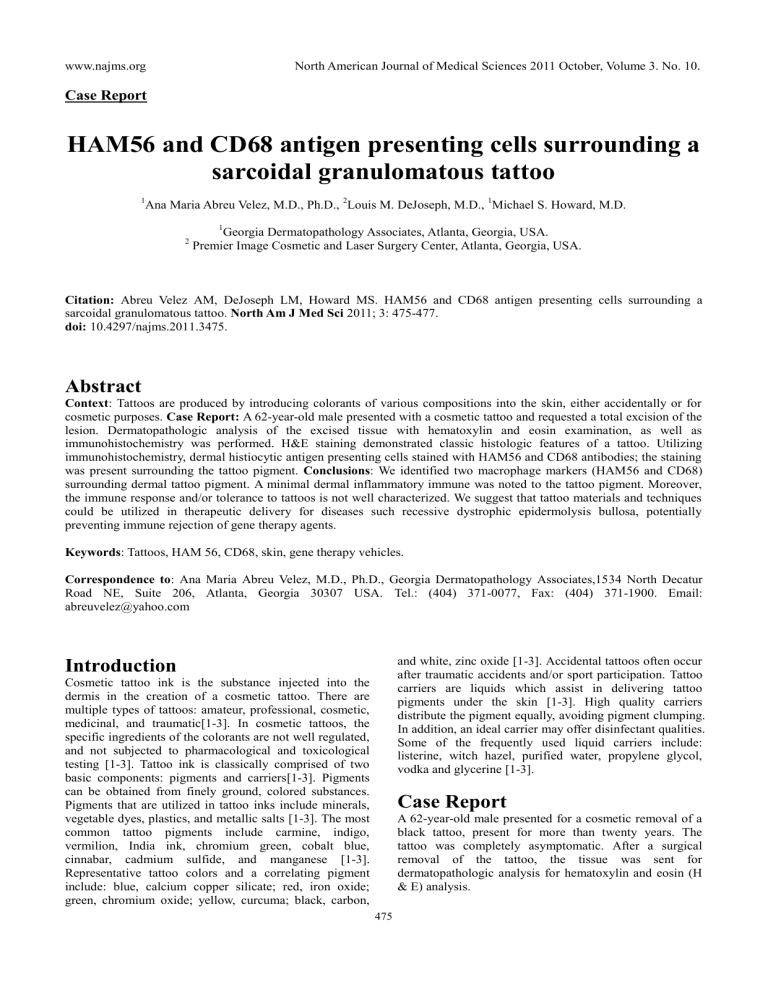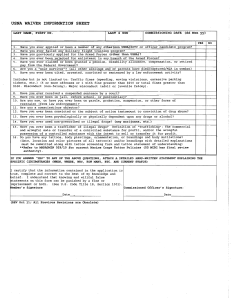
www.najms.org North American Journal of Medical Sciences 2011 October, Volume 3. No. 10. Case Report HAM56 and CD68 antigen presenting cells surrounding a sarcoidal granulomatous tattoo 1 Ana Maria Abreu Velez, M.D., Ph.D., 2Louis M. DeJoseph, M.D., 1Michael S. Howard, M.D. 1 2 Georgia Dermatopathology Associates, Atlanta, Georgia, USA. Premier Image Cosmetic and Laser Surgery Center, Atlanta, Georgia, USA. Citation: Abreu Velez AM, DeJoseph LM, Howard MS. HAM56 and CD68 antigen presenting cells surrounding a sarcoidal granulomatous tattoo. North Am J Med Sci 2011; 3: 475-477. doi: 10.4297/najms.2011.3475. Abstract Context: Tattoos are produced by introducing colorants of various compositions into the skin, either accidentally or for cosmetic purposes. Case Report: A 62-year-old male presented with a cosmetic tattoo and requested a total excision of the lesion. Dermatopathologic analysis of the excised tissue with hematoxylin and eosin examination, as well as immunohistochemistry was performed. H&E staining demonstrated classic histologic features of a tattoo. Utilizing immunohistochemistry, dermal histiocytic antigen presenting cells stained with HAM56 and CD68 antibodies; the staining was present surrounding the tattoo pigment. Conclusions: We identified two macrophage markers (HAM56 and CD68) surrounding dermal tattoo pigment. A minimal dermal inflammatory immune was noted to the tattoo pigment. Moreover, the immune response and/or tolerance to tattoos is not well characterized. We suggest that tattoo materials and techniques could be utilized in therapeutic delivery for diseases such recessive dystrophic epidermolysis bullosa, potentially preventing immune rejection of gene therapy agents. Keywords: Tattoos, HAM 56, CD68, skin, gene therapy vehicles. Correspondence to: Ana Maria Abreu Velez, M.D., Ph.D., Georgia Dermatopathology Associates,1534 North Decatur Road NE, Suite 206, Atlanta, Georgia 30307 USA. Tel.: (404) 371-0077, Fax: (404) 371-1900. Email: abreuvelez@yahoo.com and white, zinc oxide [1-3]. Accidental tattoos often occur after traumatic accidents and/or sport participation. Tattoo carriers are liquids which assist in delivering tattoo pigments under the skin [1-3]. High quality carriers distribute the pigment equally, avoiding pigment clumping. In addition, an ideal carrier may offer disinfectant qualities. Some of the frequently used liquid carriers include: listerine, witch hazel, purified water, propylene glycol, vodka and glycerine [1-3]. Introduction Cosmetic tattoo ink is the substance injected into the dermis in the creation of a cosmetic tattoo. There are multiple types of tattoos: amateur, professional, cosmetic, medicinal, and traumatic[1-3]. In cosmetic tattoos, the specific ingredients of the colorants are not well regulated, and not subjected to pharmacological and toxicological testing [1-3]. Tattoo ink is classically comprised of two basic components: pigments and carriers[1-3]. Pigments can be obtained from finely ground, colored substances. Pigments that are utilized in tattoo inks include minerals, vegetable dyes, plastics, and metallic salts [1-3]. The most common tattoo pigments include carmine, indigo, vermilion, India ink, chromium green, cobalt blue, cinnabar, cadmium sulfide, and manganese [1-3]. Representative tattoo colors and a correlating pigment include: blue, calcium copper silicate; red, iron oxide; green, chromium oxide; yellow, curcuma; black, carbon, Case Report A 62-year-old male presented for a cosmetic removal of a black tattoo, present for more than twenty years. The tattoo was completely asymptomatic. After a surgical removal of the tattoo, the tissue was sent for dermatopathologic analysis for hematoxylin and eosin (H & E) analysis. 475 www.najms.org North American Journal of Medical Sciences 2011 October, Volume 3. No. 10. Immunohistochemistry (IHC) studies were performed as previously described [4, 5]. Our macrophage HAM56 mouse monoclonal antibody was obtained from GenWay Biotech, Inc.(San Diego, California, USA). We also tested for monoclonal mouse anti-human CD68 (Dako, Carpinteria, California, USA) coloring remains. The most common reactions to tattoos are 1) photosensitivity, 2) formation of granulomatous reactions(including in a few cases sarcoidoial lesions), 3) milium cysts, and 4) hypersensitivity reactions to any of the tattoo components [2]. Although some modern tattoo inks are advertised to be 100% safe, these reactions may occur with their usage. The plastic-based pigments have been reported to be involved in multiple adverse reactions. These pigments are undoubtedly risky, with some of them containing toxic components [2]. Nuclear magnetic resonance and mass spectroscopy can help to determine the specific substances within a tattoo; in our case, these tests were not performed. Examination of the H & E tissue sections demonstrated a histologically unremarkable epidermis. In addition, dark, granular pigment deposition was observed in focal areas of the dermis. In many areas, sarcoidal granulomas surrounded the pigment deposits (Figure 1). Next, IHC staining demonstrated positive staining with HAM56 and CD68, both highlighting cells engulfing the pigment in these areas of the dermis (Figure 1). After reviewing of the literature, we found minimal information regarding the immune response to tattoos. In our case, we document the presence of HAM56 and CD68 cell populations responding to the tattoo; both of these markers highlight active antigen presenting cells. The CD68 molecule has other monikers, including GP110, SCARD1 and DKFZp686M18236. The CD68 protein gene encodes a 110-kD transmembrane glycoprotein that is highly expressed by human monocytes and tissue macrophages [6-8]. The CD68 protein is a member of the lysosomal/endosomal-associated membrane glycoprotein family [6-8]. The protein is also a member of the scavenger receptor family. Scavenger receptors typically function to clear cellular debris, promote phagocytosis and mediate the recruitment and activation of macrophages. HAM56 labels human tissue macrophages, germinal center tingible body macrophages, interdigitating histiocytes of lymph nodes, Kupffer cells of the liver and alveolar macrophages within the lung [6-8]. The anti-HAM56 antibody reacts with monocytes, but is not reactive with B or T lineage lymphocytes [6-8]. Extended studies on tattoos may provide a better understanding of how the immune system interfaces with tattoo components. These studies could lead to the development of a future modified “tattoo” vaccination gun. Such a modified gun would utilize no ink; rather, it would contain a vibrating solid needle and insert implants of DNA fragments or other substances under the skin, utilizing tattoo components as delivery vehicles. We suggest that delivery of gene therapy via such a system could advance the efficacy of the therapy, vis-à-vis prevention of interference from the immune system via the non-immunologic, or “neutral foreign body” features of selected tattoo components. Fig. 1 a. H & E sections demonstrate dark, granular tattoo pigment in the dermis (red arrow, 400X) .b, c and d Note positive IHC staining with HAM56 antibody (red/brown staining; blue arrows at 400, 200 and 100x, respectively). e. IHC CD68 staining near upper and intermediate dermal blood vessels (brown staining; red arrows, 40x). f. IHC CD68 staining near blood vessels around dermal pilosebaceous units (brown staining; red arrows, 100x). g IHC HAM56 positive staining on histiocytic foreign body type giant cells (brown staining; red arrow) (400X and 100X, respectively). h. Positive stain using CD68 (red arrow, brown stain). i. H & E staining again shows deposits of tattoo materials, concentrated around the blood vessels (red arrows, 100x). Acknowledgement Discussion Jonathan S. Jones, HT(ASCP) at GDA for excellent technical assistance. Tattoo inks are meant to establish permanent skin color changes; however, the color made fade over time due to the immune system recognizing the tattoo as a foreign body. However, most of the pigment molecules are too large for immune system cells to destroy; thus, the The study was supported by the funding from Georgia Dermatopathology Associates, Atlanta, Georgia, USA. 476 www.najms.org North American Journal of Medical Sciences 2011 October, Volume 3. No. 10. 5. References 1. 2. 3. 4. Sweeney SM. Tattoos: a review of tattoo practices and potential treatment options for removal. Curr Opin Pediatr 2006;18:391-395. Caucanas M, El Hayderi L, Lebas E, Richert B, Dezfoulian B, Nikkels AF. Dermatological complications of temporary and indelible tattoos. Ann Dermatol Venereol 2011;138:161-162. Koljonen V, Kluger N. Specifically requesting surgical tattoo removal: are deep personal motivations involved? J Eur Acad Dermatol Venereol 2011 Jun 17. doi: 10.1111/j.1468-3083.2011.04146.x. [Epub ahead of print]. Abreu-Velez AM, Howard MS, Hashimoto T, Grossniklaus HE. Human eyelid meibomian glands and tarsal muscle are recognized by autoantibodies from patients affected by a new variant of endemic pemphigus foliaceus in El-Bagre, Colombia, South America. J Am Acad Dermatol 2010;62:437-447. 6. 7. 8. 477 Howard MS, Yepes MM, Maldonado-Estrada JG, et al. Broad histopathologic patterns of non-glabrous skin and glabrous skin from patients with a new variant of endemic pemphigus foliaceus-part 1. J Cutan Pathol 2010; 37:222-230. Kunz-Schughart LA, Weber A, Rehli M, et al. The "classical" macrophage marker CD68 is strongly expressed in primary human fibroblasts]. Verh Dtsch Ges Pathol 2003;87:215-223. Cummings TJ, Hulette CM, Bigner SH, Riggins GJ, McLendon RE. Ham56-immunoreactive macrophages in untreated infiltrating gliomas. Arch Pathol Lab Med 2001;125:637-641. Wakimoto T, Tomisaka R, Nishikawa Y, Sato H, Yoshino T, Takahashi K. Identification and characterization of human thymic cortical dendritic macrophages that may act as professional scavengers of apoptotic thymocytes. Immunobiology 2008; 213: 837-847.


